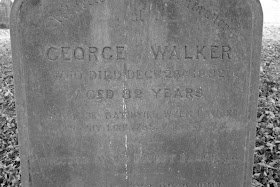 |
The cemetery
A.K.A "The Parish Church"
© Godric Godricson
|
"But your dead will live; their bodies will rise. You who dwell in the dust, wake up and shout for joy. Your dew is like the dew of the morning; the earth will give birth to her dead"
Isaiah 26:19
There is something that strikes me when I visit an English Church and that is the proximity of the living and the dead. This proximity brings us back to the idea of Christianity being nothing more than a cult of the dead. In prayer, we cast our eyes upwards and we notice the plaques on the wall extolling the virtues of the departed. We notice the arms and titles of the great landowners and we are reminded that this building is often little more than a charnel house for the rich and famous.
Indeed, if churchgoers could develop x-ray vision or a personalised ground penetrating radar we would find the floor of any parish Church as a honeycomb of vaults and tombs fashioned from the 14th Century onwards. The vaults, full of humanity, would stretch as far as the eye can see. In this way we sense both the desire for salvation of past generations alongside their fear that God will seek revenge upon them. Regrettably, this mindset of fear and anxiety is not a modern way to design a building or lay out a cemetery.
The parish Church is a very real series of contradictions. On the surface, the Church is an apparent place of serenity and prayer and yet, underneath, there is nothing but death and decay. The line quoted above, drawn from Isaiah, is by 21st century standards a truly creepy statement. The quotation is saying something about the Church as being a 'parking lot' for the dead. The parish Church becomes a place where we are laid down like a fine wine awaiting the time when we rise again and 'pop' like a champagne bottle. The parish Church, rather than being a place of serenity, becomes the loci of a death cult where the living focus on nothing but death and dying. Oh dear, this theology of death seems far removed from the account of the Resurrection containing hope and joy. The cult of death is writ large in our society and the parish Church is the heart of the cult situated in most villages.
I am not convinced that the Church has anything very much to offer to a modernising society and the photograph above is a little charitable to the Church. When I visited the parish the Church had children's toys and games in the main areas. The altar had been moved into the main body of the Church from the east end. The children's toys was a sign that this ancient cult of the dead was striving for a sort of modernity and 'applicability'. However, the Church Authorities had missed the point. Rather than being open, inclusive and modern, the parish Church holds onto the older ties to death whilst trying to support past errors by appearing 'modern'. The parish Church becomes a whited sepulchre rather than a focus for the community.
I understand the English and their sensibilities. The English easily fall down at the feet of 'tradition' and 'power' before they gently and quietly melt away away to 'do their own thing'. That the Church has lasted so long in English culture is a testimony to the holding power of this cult of the dead. My greatest hope is that the 'cult of the dead' that passes for a state religion is left behind. Let the parish Church become a creche for the one or two children of the village if that is what the community really wants although think about this......who would have a Creche in a cemetery?
































